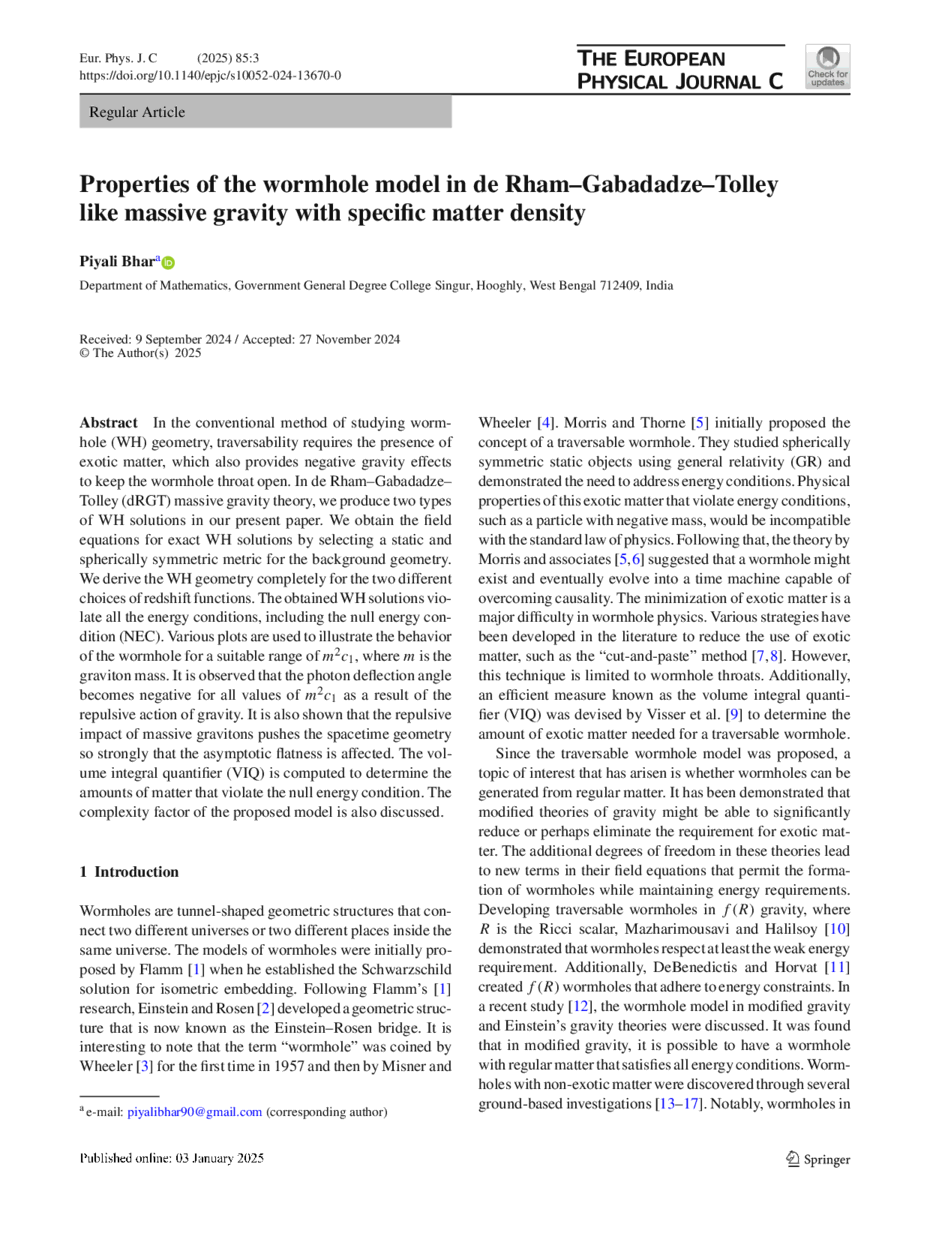https://doi.org/10.1140/epjc/s10052-024-13670-0
Regular Article
Properties of the wormhole model in de Rham–Gabadadze–Tolley like massive gravity with specific matter density
Department of Mathematics, Government General Degree College Singur, 712409, Hooghly, West Bengal, India
Received:
9
September
2024
Accepted:
27
November
2024
Published online:
3
January
2025
In the conventional method of studying wormhole (WH) geometry, traversability requires the presence of exotic matter, which also provides negative gravity effects to keep the wormhole throat open. In de Rham–Gabadadze–Tolley (dRGT) massive gravity theory, we produce two types of WH solutions in our present paper. We obtain the field equations for exact WH solutions by selecting a static and spherically symmetric metric for the background geometry. We derive the WH geometry completely for the two different choices of redshift functions. The obtained WH solutions violate all the energy conditions, including the null energy condition (NEC). Various plots are used to illustrate the behavior of the wormhole for a suitable range of  , where m is the graviton mass. It is observed that the photon deflection angle becomes negative for all values of
, where m is the graviton mass. It is observed that the photon deflection angle becomes negative for all values of  as a result of the repulsive action of gravity. It is also shown that the repulsive impact of massive gravitons pushes the spacetime geometry so strongly that the asymptotic flatness is affected. The volume integral quantifier (VIQ) is computed to determine the amounts of matter that violate the null energy condition. The complexity factor of the proposed model is also discussed.
as a result of the repulsive action of gravity. It is also shown that the repulsive impact of massive gravitons pushes the spacetime geometry so strongly that the asymptotic flatness is affected. The volume integral quantifier (VIQ) is computed to determine the amounts of matter that violate the null energy condition. The complexity factor of the proposed model is also discussed.
© The Author(s) 2025
 Open Access This article is licensed under a Creative Commons Attribution 4.0 International License, which permits use, sharing, adaptation, distribution and reproduction in any medium or format, as long as you give appropriate credit to the original author(s) and the source, provide a link to the Creative Commons licence, and indicate if changes were made. The images or other third party material in this article are included in the article’s Creative Commons licence, unless indicated otherwise in a credit line to the material. If material is not included in the article’s Creative Commons licence and your intended use is not permitted by statutory regulation or exceeds the permitted use, you will need to obtain permission directly from the copyright holder. To view a copy of this licence, visit http://creativecommons.org/licenses/by/4.0/.
Open Access This article is licensed under a Creative Commons Attribution 4.0 International License, which permits use, sharing, adaptation, distribution and reproduction in any medium or format, as long as you give appropriate credit to the original author(s) and the source, provide a link to the Creative Commons licence, and indicate if changes were made. The images or other third party material in this article are included in the article’s Creative Commons licence, unless indicated otherwise in a credit line to the material. If material is not included in the article’s Creative Commons licence and your intended use is not permitted by statutory regulation or exceeds the permitted use, you will need to obtain permission directly from the copyright holder. To view a copy of this licence, visit http://creativecommons.org/licenses/by/4.0/.
Funded by SCOAP3.





